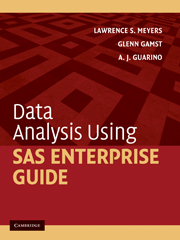Book contents
- Frontmatter
- Contents
- Preface
- Acknowledgments
- I Introducing SAS Enterprise Guide
- II Performing Analyses and Viewing Output
- III Manipulating Data
- IV Describing Data
- V Score Distribution Assumptions
- VI Correlation and Prediction
- VII Comparing Means: The t Test
- 20 Independent-Groups t Test
- 21 Correlated-Samples t Test
- 22 Single-Sample t Test
- VIII Comparing Means: ANOVA
- IX Nonparametric Procedures
- X Advanced ANOVA Techniques
- XI Analysis of Structure
- References
- Author Index
- Subject Index
20 - Independent-Groups t Test
Published online by Cambridge University Press: 05 June 2012
- Frontmatter
- Contents
- Preface
- Acknowledgments
- I Introducing SAS Enterprise Guide
- II Performing Analyses and Viewing Output
- III Manipulating Data
- IV Describing Data
- V Score Distribution Assumptions
- VI Correlation and Prediction
- VII Comparing Means: The t Test
- 20 Independent-Groups t Test
- 21 Correlated-Samples t Test
- 22 Single-Sample t Test
- VIII Comparing Means: ANOVA
- IX Nonparametric Procedures
- X Advanced ANOVA Techniques
- XI Analysis of Structure
- References
- Author Index
- Subject Index
Summary
Overview
The independent-groups t test is a procedure to determine if the means of exactly two independent distributions are significantly different. Because a one-way between-subjects analysis of variance (ANOVA) design is the general case of the independent-groups t test, and because t2 = F, it is common practice to defer to the ANOVA for two-group as well as multigroup designs. However, the t test is well worth covering in statistics courses, and we believe it is of sufficient importance to cover in this book as well.
Some history
William Sealy Gosset, a chemist and mathematician, was hired in 1899 by the Guinness Brewing Company. As Salsburg (2001) tells the story, in the context of monitoring the brewing of that beer, Gosset developed several statistical innovations that he wished to publish in the professional literature. However, to protect trade secrets, the company prohibited its employees from publishing their work. Gosset therefore devised a pseudonym with the help of Karl Pearson so that he could disseminate his work in Pearson's Biometrika. The pseudonym that they devised was the name Student, and in 1908 Student published an article describing a new statistical test and its distribution. The letter t was selected by Gosset and Pearson as the name of the test and distribution because it was the last letter of the word Student.
- Type
- Chapter
- Information
- Data Analysis Using SAS Enterprise Guide , pp. 195 - 200Publisher: Cambridge University PressPrint publication year: 2009



